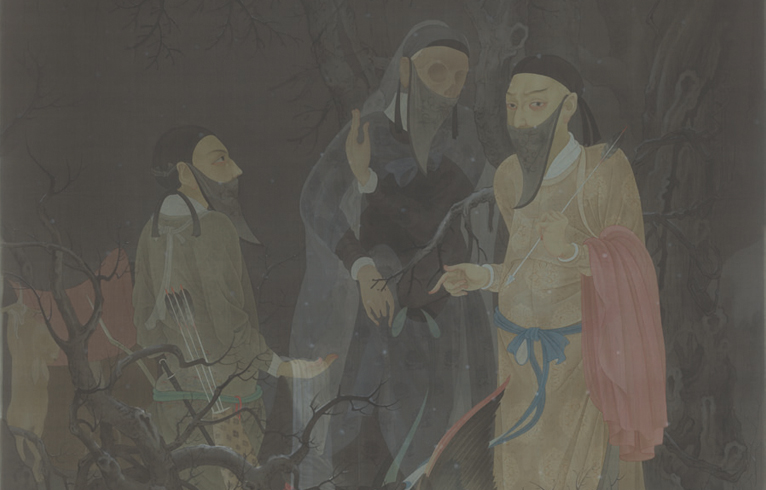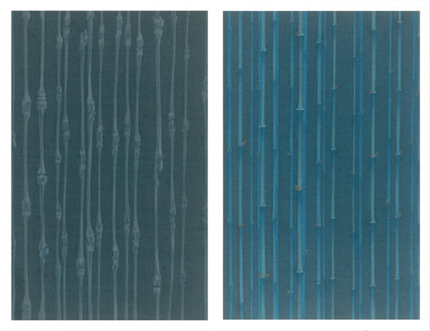HAO LIANG: ILLUSORY INK
| March 27, 2012 | Post In LEAP 13

WESTERN PHILOSOPHY, especially Kantian philosophy, is consistent on one point: the distinction between noumenon— the thing in and of itself— and phenomenon— the thing as perceived. Traditional Chinese philosophy, however, holds no such distinction; if anything, the two are combined in the arching concept of the bengen (literally, the “root” of all things). If one were to take painting as an expression of this worldview, then the monumental and often fantastical landscapes of the Northern Song could be seen as its visual paradigm. Although representational and stylistic elements from the whole of traditional Chinese painting— and indeed, from periods in Western and Middle Eastern art history— can be found in Hao Liang’s work, it is from the apex of the twelfth and thirteenth centuries that the young painter takes most inspiration: from the artistic meeting of reality and illusion, and from the deceptively elemental strokes of ink that unite the two.
This is not to say that Hao Liang paints landscapes; in fact, he has not yet completed his first major depiction of shanshui. In the 14-piece Treatise on Bamboo Skeleton Painting, for example, Hao is more concerned with elaborating upon the three key technical qualities developed in Northern Song landscapes— high distance, deep distance, and level distance— and compressing these qualities along with qualities developed later on in Chinese art history in tightly bound metaphysical narratives. His first solo exhibition, “Nest Image” at My Humble House in Taipei— a gallery that boasts a demonstrable commitment to the perpetuity of traditional Chinese painting— provides a fitting first account of this aspect of his practice. Set in traditional butterfly leaf, Treatise on Bamboo Skeleton Painting is a formal extension of the writings of Yuan-dynasty scholars Wu Zhen and Li Kai, which set the foundation for subsequent literati painting. In pairs of two, the equation of the bamboo plant with the human skeleton— on one leaf, bamboo shoots rise from the ground, and on the corresponding leaf sprout human metacarpals; flowers bloom from a stalk of spinal chord, while leaves emerge from actual bamboo; and so on— chronologically recount the life cycle of the universe as we know it, from birth to death. In the stage of full maturation, one dense forest of bamboo and one of bones fill the respective picture planes, receding away from the viewer. Here, Hao may as well have painted two mirrors opposite one another, in eternal reflection; the repeating contraction seems to be his visualization of the landscape of the mind. This is Hao’s bengen of the brush: sharp vertical lines carefully edged with ink wash, all bathed in a somber palette of dark blue, gray, and green, achieve a momentary unification of noumenon and phenomenon. No matter at which leaf the viewer gazes, the simple blink of an eye posits illusion as part and parcel with reality.
Then, there are Hao Liang’s figure paintings, in which an even more powerful emphasis on technique is visible, driven by a weaving of Western art into his silk canvases. In some of these, the integration of Song academic painting and Renaissance painting amounts to a mesmerizing synthesis of East and West portraiture. In one panel of Theology and Evolution, an aged scholar takes fairy-tale rabbit form, as if the Brothers Grimm were born in eleventh-century Kaifeng. In Body Mystery, an actor of commedia dell’arte spurns Confucian etiquette by donning an open robe— and grimly revealing flesh only half-there.

In Shadowy Buddha, a man faces the viewer at a 45-degree angle, a patterned scarf hiding the lower half of his face. The scene is normal in certain respects. On his overturned left hand sits a blue bird, and in the lower left corner, a black falcon— both a nod to the “lowest” form of ink painting, the flower-and-bird painting preferred by Emperor Huizong of the Northern Song. The trained viewer will notice a scholar’s rock jutting out of the lower right of the frame, and depth achieved through the contrast of plants in the foreground and faint vines of flowers floating in the black background. Yet certain elements disturb this normalcy. Pinched between the thumb and index finger of his right hand, which is poised in a gesture reminiscent of the Buddhist iconographic mudra for “wisdom,” is an eyeball. His own eye sockets sag in tubercular red, and his feet hover slightly above the ground. Least visible, but most evidential of painterly skill— and of metaphysical probing— is the faint presence of the man’s skeleton beneath his robes. Overall, the depiction seems to be a scene from diyu, the hell of Chinese mythology, the semblance to which is more obviously heightened in The Hunter and the Transformations of Hell. Here, three hovering figures— again, mouths hidden behind scarves, and the hands of each in Buddhist mudra positions— meet in what appears to be a barren nighttime glade. On the left and behind craggy brush stands the hunter, facing the other two in supplication. The figure in the middle is of a corpse in a state of advanced decomposition, and the one on the right holds one of the hunter’s arrows. Between the three, a skeleton feebly emerges from a hole in the ground, emanating a soft glowing light. And floating above the picture plane of Spider’s Web Garden, clusters of fine, nearly translucent white strokes sit at angles from one another together to form apparitions amidst the flora: hallucinations of a wolf, a peacock, and a falcon.
In these works, Hao Liang’s veneration for the technical standards, intricacy of detail, and spiritual endeavor of traditional Chinese painting runs so deep that his practice necessarily moves beyond mere reproduction and elaboration: he directly confronts issues that previous compositions would only allude to. As opposed to, for example, Guo Xi’s masterpiece Old Trees, Level Distance— in which death and impermanence is merely suggested, by the parting of two elderly friends— the aforementioned works assemble death quite frankly, in figure, pigment, brushwork, and narrative. Yet, none of this is to say that Hao’s painting is morbid. A more suitable term would be grotesque.
As summarized by Michael Steig, the German scholar Wolfgang Kayser defines the grotesque fundamentally as “the power to evoke in the viewer a sense of the radical alienness of the world… its ‘estrangement’ from man, its essential absurdity… by depicting a world at least intermittently under the sway of ‘demonic’ forces.” Viewers would be hard-pressed to argue that Hao Liang’s painting does not conform with this definition, especially in the 28 miniature frames of his “Dissection Series”: x-ray paintings of bodies in Florentine garb, a still life of an extracted human heart, a human skull in a doctor’s cabinet, operating-theater views of surgery on translucent corpses, and so on. The “alienness” of the world is rarely as accessible as with the phenomena of our own anatomy made visible, a fact Hao skillfully exploits here with his horsehair brush. (Here, one can almost imagine Hao Liang as a Ming-dynasty literati who had formed a friendship with the Jesuit astronomer Johann Adam Schall von Bell, who would have inspired Hao’s imagination with books on human autopsy brought from Europe.) As with all persistent forms of the grotesque in art and literature, much of his success in doing so lies on aesthetic grounds, as the viewer fails to find his painting repulsive, but instead, may even find it beautiful.
By semantic association, the grotesque leads to chimera: that thing that is hoped or wished for but in fact is illusory or impossible to achieve. Gazing at Hao Liang’s skeletons, one can almost overcome the reluctance to admit the hope that such physiological freakishness were possible, that one could see through human skin, hover above ground, walk through a forest of bones, and meet the human-sized rabbit-scholar. In short, ours is a yearning for illusion to be reality, and possibly vice versa. This is not quite yet feasible for our human cognizance, but therein lies the allure of painting. As long as this young painter continues to discover possibilities for joining the phenomena of the cosmos with the noumena, his own allure shall continue to expand.

